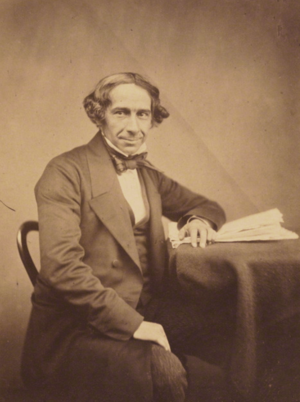William Wilson Saunders facts for kids
William Wilson Saunders (born June 4, 1809 – died September 13, 1879) was a British expert in many fields. He worked as an insurance broker, but he was also a very important entomologist (someone who studies insects) and a botanist (someone who studies plants). He was even a FRS, which is a big honor for scientists!
Contents
Who Was William Saunders?
William Saunders worked as an underwriter at Lloyd's of London. This means he helped assess risks for insurance. But his real passion was the natural world.
His Role in Science Societies
Saunders was a leader in several important science groups:
- He was the president of the Entomological Society twice. He led the society from 1841 to 1842 and again from 1856 to 1857.
- He was also the treasurer for the Linnean Society of London for many years, from 1861 to 1873. This society is famous for its work in classifying living things.
- In 1853, he became a Fellow of the Royal Society, which is one of the oldest and most respected scientific organizations.
Saunders as a Plant and Insect Collector
William Saunders lived in a place called Reigate. He was known for his love of plants and gardening, making him a skilled horticulturalist.
His main interest in insects was with Lepidoptera (butterflies and moths) and Hymenoptera (bees, wasps, and ants). However, his amazing collection included insects from almost every type of insect group.
The Insecta Saundersiana Collection
Saunders had a huge collection of Diptera (flies). Many of these were new species that scientists had never seen before! These new flies were described in a series of papers by another expert, Francis Walker. This important work was called Insecta Saundersiana.
What Others Said About His Collection
A famous explorer and naturalist, Alfred R. Wallace, wrote about Saunders's collection in his book, The Malay Archipelago. Wallace said that Saunders had nearly two thousand types of beetles and hundreds of butterflies that had already been studied. But even more were still waiting to be described!
Wallace also mentioned that a lot of work was done by Francis Polkinghorne Pascoe. Pascoe helped sort and describe Saunders's large collection of Longicorn beetles. There were more than a thousand species of these beetles, and about nine hundred of them were completely new to science!
Saunders's collection also had over two thousand other insect species. Many of these were described by other good entomologists. For example, he had more than nine hundred species of Hymenoptera (like bees and ants). Among these, there were 280 different kinds of ants, and 200 of those were brand new discoveries! This shows how important William Saunders's collection was for understanding insects.


